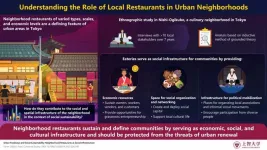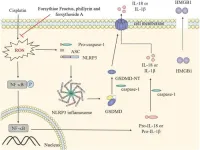(Press-News.org)
Studies on sustainability inevitably touch on food-related topics like food security, culinary heritage, and the sustenance of vulnerable people. Social sustainability is one of the three pillars of sustainability, alongside environmental and economic sustainability, and has become a pivotal topic in various research fields. It includes concerns about social justice, resource distribution and recognition, and political participation of marginalized groups at the local community level.
Very few studies of social sustainability have looked at urban foodways in terms of social and cultural infrastructure. More often than not, scholars in Japan have been concerned with how communities preserve culinary heritage, including traditional foods and eateries, especially in the face of globalization and modernization. In short, the question has been one of how communities preserve their foodways.
But what if we flipped the question? In a recent study published online on 05 October 2023 in Food, Culture & Society, Professor James Farrer of Sophia University, Japan, did this precisely by focusing on how commercial foodways (as spots for social interaction and integration) help sustain their communities. To this end, he undertook an ethnographic investigation in Nishi–Ogikubo (also known as “Nishiogi”), a culinary neighborhood in Tokyo, home to a high density of small eateries. The idea was to understand how independent restaurants in this busy neighborhood support community life, particularly when redevelopment and corporatization are destroying these aspects of city life. “In Tokyo, I observed that neighborhood restaurants, particularly small independent restaurants, serve as social infrastructure for communities. Beyond grabbing a meal and helping someone make a living, they also serve to support the social and cultural life of the community in important ways,” explains Prof. Farrer.
Prof. Farrer considered Nishiogi, a single neighborhood in Suginami district, as the study’s unit of analysis to generate insights that could be extended to the rest of Tokyo and other cities of the world. To gather information for his qualitative analyses, he focused on multiple small-scale and independently owned restaurants in Nishiogi over the course of seven years. With the help of research assistants, Prof. Farrer interviewed over 70 stakeholders in the community, including business owners and local realtors.
After a comprehensive analysis of all the gathered data, Prof. Farrer arrived at some important conclusions about the role of neighborhood eateries with respect to social sustainability. First, he observed that eateries in Nishiogi are an important economic resource for employers, workers, and customers. These places serve as a source of livelihood not only for dozens of Japanese families but also for migrants from around the world. Notably, neighborhood restaurants proved to be an effective entry point for low-resource people, including disadvantaged minorities, single mothers, and youth, into business ownership.
Second, neighborhood eateries provide a space for social organization, integration, and networking, making it possible to create and deploy social capital. By enabling customers and workers to form new social ties, the community becomes more tightly knit, which is helpful from the point of view of social sustainability. For example, social ties and capital established can serve as a safety net for vulnerable patrons or crises like the COVID-19 pandemic.
Third, the study revealed that eateries can become important spaces for political mobilization. This includes not only formal movements like merchant associations but also diverse informal social movements and activism addressing local causes and issues. Interestingly, because eateries now play an important role in generating social capital, customers become central to these movements, with diverse people like women, youngsters, and newcomers getting involved in decision-making.
In summary, these findings suggest that small neighborhood eateries, especially local and independently owned ones, can be instrumental in fostering social sustainability and cohesion. Protecting them from the threats of urbanization is, therefore, essential. “It is important for Tokyo urban planners and citizen groups to understand how neighborhood eateries serve as social infrastructure, particularly, the role of independent restaurants in supporting the community economically, socially, and politically. This is because with rapid urban redevelopment, aging, and the rise of corporate restaurant chains, Tokyo is at a risk of losing this social infrastructure,” adds Prof. Farrer.
Prof. Farrer is optimistic about these findings and hopes that they can contribute to helping Tokyo sustain a dense and diverse ecology of independent eateries, which, in turn, could become a model for other cities around the world.
We hope to see these findings act as a stepping stone towards truly sustainable societies in the future!
Reference
【Title of original paper】Urban foodways and social sustainability: neighborhood restaurants as social infrastructure
【Journal】Food, Culture & Society
【DOI】10.1080/15528014.2023.2262191
【Authors】James Farrar
【Affiliations】Graduate School of Global Studies, Sophia University
END
The transition to a society without fossil fuels means that the need for batteries is increasing at a rapid pace. At the same time, the increase will mean a shortage of the metals lithium and cobalt, which are key components in the most common battery types. One option is a sodium-ion battery, where table salt and biomass from the forest industry make up the main raw materials. Now, researchers from Chalmers University of Technology, Sweden, show that these sodium-ion batteries have an equivalent climate impact as their lithium-ion counterparts – without the risk of running out of raw materials.
"The materials ...
Research Highlights:
An analysis of death certificate data from 1999 to 2020 showed a decline in deaths related to infective endocarditis throughout most of the United States yet found an alarming increase of 2%-5% among adults ages 25-44.
There was a notable increase in the diagnosis of substance use disorder among the young adults with infective endocarditis listed as the underlying cause of death.
Three states at the epicenter of the opioid crisis— Kentucky, Tennessee and West Virginia — had significant increases in death rates related to infective endocarditis.
Embargoed until 4 a.m. CT/5 a.m. ET Wednesday, Dec. 13, 2023
DALLAS, Dec. 13, 2023 — ...
Smartwatches can help physicians detect and diagnose irregular heart rhythms in children, according to a new study from the Stanford School of Medicine.
The finding comes from a survey of electronic medical records for pediatric cardiology patients receiving care at Stanford Medicine Children’s Health. The study will publish online Dec. 13 in Communications Medicine.
Over a four-year period, patients’ medical records mentioned “Apple Watch” 145 times. Among patients whose medical records mentioned ...
VANCOUVER, Wash. – Even in the precipitation-heavy Pacific Northwest, more frequent heatwaves are threatening a key source of water supply.
A Washington State University study that intended to look at snow melting under a single, extreme event, the 2021 “heat dome,” instead revealed an alarming, longer-term rising trend of successive heatwaves melting snowpack earlier in the year.
The findings have implications for many areas worldwide that are dependent on snow-capped mountains to provide summer water since heatwaves have been on the rise globally.
“Short-term ...
Barcelona and Johannesburg, December 13th, 2023
The Scientific Group, a leader in the IVD industry, and Inbiomotion, a company commercializing its proprietary MAF Test® for identifying high risk early-stage breast cancer patients have signed an agreement to start marketing MAF Test® in Sub-Saharan Africa. The MAF Test® predicts the prognosis of breast cancer patients and helps oncologists to identify those patients who may be able to prevent recurrence and benefit from adjuvant treatment with bisphosphonates, which are commonly used to treat osteoporosis. The test also identifies those patients whose prognosis would worsen if treated with bisphosphonates.
Breast ...
People with cognitive disabilities – like autism, attention deficit and memory loss – are less satisfied with their health care than those in the general population, according to a study published by a Rutgers researcher.
The study, published in Disability and Health Journal, examined how a national sample of adults experience the care they receive and the factors that contribute to their experiences.
“People with cognitive disabilities were less likely than people without ...
In the future, a little saliva may be enough to detect an incipient cancer. Researchers at the University of Gothenburg have developed an effective way to interpret the changes in sugar molecules that occur in cancer cells.
Glycans are a type of sugar molecule structures that is linked to the proteins in our cells. The structure of the glycan determines the function of the protein. It has been known for a while that changes in glycan structure can indicate inflammation or disease in the body. Now, researchers at the University of Gothenburg have developed a way to distinguish different ...
Beneath Svalbard’s permafrost, millions of cubic meters of methane are trapped — and scientists have now learned that it can migrate beneath the cold seal of the permafrost and escape. A large-scale escape could create a cycle of warming that would send methane emissions skyrocketing: warming thaws the permafrost, causing more gas to escape, allowing more permafrost to thaw and more gas to be released. Because Svalbard’s geological and glacial history is very similar to the rest of the Arctic region, these migrating deposits of methane are likely ...
People are less likely to adopt new health policies if they don't have faith in their government, and a new tool from University of Waterloo researchers aims to fix that.
The tool – designed by a team based in Waterloo's School of Public Health Sciences - aids lawmakers in how trustworthy they may appear to the public and could help improve the uptake of public health policies by informing their design and communication.
Policymakers can use the tool to measure citizens' trust in government and inform the design and communication of public health initiatives in ways that build confidence across members of ...
Chemotherapy-induced nausea and vomiting (CINV) are among the most prevalent and distressing side effects faced by patients undergoing antineoplastic treatments. This condition can lead to complications such as dehydration, metabolic imbalances, anorexia and weakened physical stamina. Notably, highly emetic drugs such as cisplatin are notorious for causing severe nausea and vomiting in approximately 90% of patients. Therefore, enhancing the management of CINV is of utmost importance.
Chemotherapy-induced inflammation in the gastrointestinal tract is considered ...






